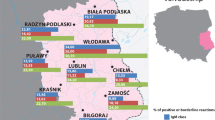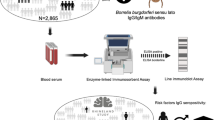Abstract
In order to assess the seroprevalence of Borrelia burgdorferi in Romania and to define associated risk factors, a cross-sectional, observational study was performed in 13 districts during 1999. Sera from healthy blood donors (1598) and from forestry workers (1048) were tested. A two-step testing strategy was used in which sera were tested for anti-B. burgdorferi antibodies by a commercially available passive hemagglutination assays (PHA). All PHA positive sera were then evaluated by Western blot IgG. Demographic data regarding age, sex, profession, work place/residence, duration of employment (forestry workers), animals in the environment, and tick bites history were collected using a questionnaire. Data obtained from serological study were matched with that obtained from the questionnaire. The seroprevalence of B. burgdorferi in blood donors was of 4.3% (range 1.4–8.7%) and 9.3% (range 2.8–31.7%) in forestry workers. Seroprevalence was higher in forestry workers with a tick bite history (10.7 vs. 4.3%, p < 0.05). The highest seroprevalence in blood donors (8.7%) was noted in Maramures, a northern district of the country, whereas in forestry workers the highest seroprevalence (31.7%) was observed in a western district (Arad), where a previous study in entomology has demonstrated the highest density of Ixodes ricinus ticks in Romania.
Similar content being viewed by others
References
Rath PM, Ibershoff B, Mohnhaupt A, et al. Seroprevalence of lyme borreliosis in forestry workers from Brandenburg, Germany. Eur J Clin Microbiol Infect Dis 1996; 15: 372–377.
Pejcoch M, Kralikova Z, Strnad P, et al. Prevalence of antibodies to Borrelia burgdorferi in forestry workers of south Moravia. Zentralblatt fur Bakteriologie 1988; (Suppl. 18): 317–320.
Moll van Charante AW, Groen J, Mulder PGH, et al. Occupational risks of zoonotic infections in Dutch forestry workers and muskrat catchers. Eur J Epidemiol 1998; 14: 109–116.
Burek V, Misik-Mayerus L, Maretic T. Antibodies to Borrelia burgdorferi in various population groups in Croatia. Scand J Infect Dis 1992; 24: 683–684.
Christiann F, Rayet P, Patey O, et al. Lyme borreliosis in central France: A sero-epidemiologic examination involving hunters. Eur J Epidemiol 1997; 13: 855.
Gustafson R, Forsgren M, Gardulf A, et al. Antibody prevalence and clinical manifestations of Lyme borreliosis and tick-borne encephalitis in Swedish orienteers. Scand J infect Dis 1993; 25: 605–611.
Steere AC. Lyme disease. N Engl J Med 2001; 345(2): 115–125.
Pop D, Dutschak K, Rosiu N, et al. Un caz de boala Lyme detectat în România. Bacteriologia, Virusologia, Parazitologia. Epidemiologia 1995; 40(3–4): 245–247.
Caăruntu F, Angelescu C, Caăruntu V, et al. Aspecte clinice sş de laborator ale infecţiei cu Borrelia burgdorferi în România. Viaţa Medicală 1988; 35(8): 353–357.
Crăcea E, Constantinescu S, Balaci L, et al. Lyme borreliosis in Romania. Arch Roum Path Exp Microbiol 1988; 47(1): 17–21.
Centers for Disease Control and Prevention. Recommendations for test performance and interpretation from the Second National Conference on Serologic Diagnosis of Lyme Disease. MMWR 1995; 44(31): 590–591.
Norman LG, Antig MJ, Bigaignon G, et al. Serodiagnosis of Lyme borreliosis by Borrelia burgdorferi sensu stricto, B. garinii, and B. afzelii Western blots (Immunoblots). J Clin Microbiol 1996; 34(70): 1732–1738.
Tugwell P, Dennis DT, Weinstein A, et al. Laboratory evaluation in the diagnosis of Lyme disease. Ann Intern Med 1997; 127: 1106–1123.
Wormser GP, Aguero-Rosenfeld ME, Nadelman RB. Lyme disease serology: Problems and opportunities. JAMA 1999; 282(1): 79–80.
Hamann-Brand A, Flondor M, Brade V. Evaluation of passive hemagglutination assays screening test and of a recombinant immunoblot as con.rmatory test for serological diagnosis of Lyme disease. Eur J Clin Microbiol Infect Dis 1994; 13(7): 572–575.
Raoult D, Hechemy KE, Baranton C. Cross-reaction with Borrelia burgdorferi antigen of sera from patients with human immunodeficiency virus infection, syphilis and leptospirosis. J Clin Microbiol 1989; 27: 2152–2155.
Feider Z. Arachnida. In: Fauna Republicii Populare Romane, 5(20). Bucuresti: Editura Academiei RPR, 1965; 84–121.
Author information
Authors and Affiliations
Rights and permissions
About this article
Cite this article
Hristea, A., Hristescu, S., Ciufecu, C. et al. Seroprevalence of Borrelia burgdorferi in Romania. Eur J Epidemiol 17, 891–896 (2001). https://doi.org/10.1023/A:1015600729900
Issue Date:
DOI: https://doi.org/10.1023/A:1015600729900




